Interlaken
Protocol Definition
A Joint Specification of Cortina Systems and Cisco Systems
Revision 1.2
October 7, 2008
Proprietary Material
This document contains information proprietary to Cortina Systems Incorporated and Cisco Systems
Incorporated. Any use or disclosure, in whole or in part, of this information to any third or unauthorized
party, for any purposes other than that for which it is provided is expressly prohibited except as authorized
by Cortina Systems or Cisco Systems in writing. This document is protected under American, Canadian,
and foreign copyright legislation which provides civil and criminal penalties for copying or distribution
without the authorization of Cortina Systems Incorporated or Cisco Systems Incorporated.
USE OF THIS SPECIFICATION IS SUBJECT TO THE LICENSE TERMS SET FORTH ON THE
FOLLOWING PAGE.
© Cortina Systems Inc. and Cisco Systems Inc., 2006−2008
�
Interlaken
Protocol Definition
Revision 1.2
October 7, 2008
Legal Disclaimers
Terms and Conditions
Cortina Systems, Inc. (“Cortina”) and Cisco Systems, Inc. (“Cisco”) (collectively, Cortina and Cisco, “We” or “Our”) desire
to encourage widespread adoption and use of the Interlaken Protocol Definition set forth in the following pages (the
“Specification”). Accordingly, Cortina and Cisco are willing to grant you a license to use the Specification, at no charge,
subject to your agreement and compliance with the following terms and conditions. PLEASE READ THESE TERMS
AND CONDITIONS CAREFULLY.
Cortina and Cisco grant you a non-exclusive, royalty-free, worldwide, perpetual license to create modifications,
adaptations, translations and derivative works based on the Specification (collectively, “Modifications”), to develop
products and systems implementing the Specification or implementing such Modifications, to make, use and sell all such
products and systems, and to make copies of the Specification as necessary to exercise the foregoing rights. Cortina and
Cisco reserve all rights not expressly granted above. For sake of clarity, no right is granted to disclose or distribute copies
of this Specification to any third party. You may not disclose or distribute the Specification, unless you receive the express
prior written consent of either Cortina or Cisco.
You agree to include a copyright notice on all complete and partial copies of the Specification as follows:
“Copyright © 2006 Cortina Systems, Inc. and Cisco Systems, Inc.” In the event that you create Modifications of the
Specification, you agree to include a notice identifying which portions of the Specifications have been modified or added
by you.
In the event that you claim any intellectual property rights that are embodied in, or practiced by, any portion of the
Specification (your “Related Rights”), you must agree not to enforce those intellectual property rights against Cortina,
Cisco, or any licensee of the Specification, or else we are unwilling to grant you the license stated above. You hereby
grant to Cortina, Cisco and all licensees of the Specification an unlimited, non-exclusive, royalty-free, worldwide,
perpetual license under all of your Related Rights.
YOU ACKNOWLEDGE THAT THE SPECIFICATION IS LICENSED TO YOU ON AN “AS IS” BASIS, W ITHOUT
WARRANTY OF ANY KIND. FOR SAKE OF CLARITY, CORTINA AND CISCO DISCLAIM ANY AND ALL
WARRANTIES, EXPRESS OR IMPLIED, WITH RESPECT TO THE SPECIFICATION, INCLUDING W ITHOUT
LIMITATION, ANY AND ALL WARRANTIES OF MERCHANTABILITY, FITNESS FOR PARTICULAR PURPOSES,
TITLE AND NONINFRINGEMENT.
IN NO EVENT WILL CORTINA OR CISCO BE LIABLE TO YOU OR TO ANY THIRD PARTY FOR ANY INDIRECT,
INCIDENTAL OR CONSEQUENTIAL DAMAGES IN CONNECTION W ITH THE SPECIFICATION, AND IN NO EVENT
WILL THE CUMULATIVE LIABILITY OF EACH OF CORTINA AND CISCO FOR ANY AND ALL CLAIMS IN
CONNECTION WITH THE SPECIFICATION EXCEED, IN AGGREGATE, ONE HUNDRED DOLLARS (U.S. $100.00).
YOU AGREE THAT THIS PARAGRAPH IS AN ESSENTIAL BASIS OF THE RIGHTS GRANTED TO YOU ABOVE, AND
THAT WE ARE UNWILLING TO GRANT YOU A LICENSE IF YOU DO NOT AGREE TO THIS PROVISION.
By using the Specification in any manner, you are agreeing to these terms and conditions. If you do not agree to these
terms and conditions, We do not grant you a license and you have no right to use the Specification, in which event your
use of this Specification would be in violation of Cortina’s and Cisco’s intellectual property rights.
Interlaken
Page 2
Proprietary Material - © Cortina Systems Inc. and Cisco Systems, Inc. 2006−2008
�
Interlaken
Protocol Definition
Revision 1.2
October 7, 2008
Contents
5.3.3
5.3.4
Contents
1.0 Revision History ............................................................................................................................6
Clarifications to Revision 1.1 ................................................................................................6
Changes to Revision 1.0.......................................................................................................6
2.0 Definitions and Key Variables......................................................................................................8
3.0
Introduction....................................................................................................................................9
4.0 Applications.................................................................................................................................10
5.0
Interlaken Protocol......................................................................................................................11
Fundamentals..................................................................................................................... 11
5.1
Basic Concepts................................................................................................................... 11
5.2
Protocol Layer..................................................................................................................... 12
5.3
Transmission Format ............................................................................................. 12
5.3.1
5.3.2
Burst Structure....................................................................................................... 13
5.3.2.1 Data Transmission Procedure ............................................................... 13
5.3.2.1.1 Optional Scheduling Enhancement..................................... 14
5.3.2.2 Control Word Format ............................................................................. 15
State Diagrams...................................................................................................... 18
Flow Control........................................................................................................... 22
5.3.4.1
Protocol.................................................................................................. 22
5.3.4.2 Out-of-Band Flow Control ...................................................................... 23
5.3.4.2.1 Out-of-Band Flow Control Interface Timing......................... 24
In-Band Flow Control ............................................................................. 24
Full-Packet Mode Flow Control..............................................................25
Flow Control Extension.......................................................................... 25
Framing Layer..................................................................................................................... 26
5.4.1 Overview................................................................................................................ 26
5.4.2
64B/67B Encoding................................................................................................. 26
5.4.3 Meta Frame ........................................................................................................... 29
Synchronous Scrambler ........................................................................................ 30
5.4.4
5.4.5
Lane Alignment...................................................................................................... 32
5.4.6
Lane Diagnostics ................................................................................................... 33
5.4.7 Clock Compensation.............................................................................................. 33
5.4.8 Overhead............................................................................................................... 35
5.4.9
Skew Budget.......................................................................................................... 36
5.4.10 Rate Matching........................................................................................................36
5.4.11 Error Conditions..................................................................................................... 38
5.4.11.1 The Receive SerDes Loses Lock........................................................... 38
5.4.11.2 The Receive Logic Loses Word Boundary Sync.................................... 39
5.4.11.3 Bad Scrambler State.............................................................................. 39
5.4.11.4 Lane Alignment Fails ............................................................................. 39
5.4.11.5 Burst CRC24 Errors............................................................................... 39
5.4.11.6 Flow Control Errors................................................................................ 39
5.4.11.7 Unknown Control Word Types............................................................... 40
5.4.11.8 Bad 64B/67B Codewords....................................................................... 40
5.4.11.9 Diagnostic CRC32 Errors....................................................................... 40
5.4.12 Lane Resiliency ..................................................................................................... 40
Electrical Specifications...................................................................................................... 40
Recommended Statistics.................................................................................................... 40
Test Patterns ...................................................................................................................... 41
5.3.4.3
5.3.4.4
5.3.4.5
1.1
1.2
5.4
5.5
5.6
5.7
Interlaken
Page 3
Proprietary Material - © Cortina Systems Inc. and Cisco Systems, Inc. 2006−2008
�
Interlaken
Protocol Definition
Revision 1.2
October 7, 2008
Figures
5.8
5.9
Latency Considerations ......................................................................................................43
Performance ....................................................................................................................... 44
6.0 Bibliography.................................................................................................................................45
Status Messaging........................................................................................................................46
A
CRC and Scrambler Calculation Details....................................................................................48
B
C
Interoperability Checklist............................................................................................................51
Figures
1
2
3
4
5
6
7
8
9
10
11
12
13
14
15
16
17
18
19
20
21
22
23
24
25
26
27
XAUI Versus SPI4.2 Interfaces .......................................................................................................9
Framer/MAC to NPU/L2 or L3 Switch............................................................................................ 10
Framer/MAC to NPU/L2 or L3 Switch............................................................................................ 10
Lane Striping Example .................................................................................................................. 12
Word Formats................................................................................................................................ 13
BurstShort Guarantee Illustration .................................................................................................. 14
Control Word Format..................................................................................................................... 16
Receive Per-Lane State ................................................................................................................ 19
Receive Interface State ................................................................................................................. 20
Transmit Interface State ................................................................................................................ 21
Out-of-Band Logical Timing Diagram ............................................................................................ 23
Out-of-Band Flow Control Timing Diagram ................................................................................... 24
64B/67B Word Boundary Lock ...................................................................................................... 28
Meta Frame Structure (Per Lane).................................................................................................. 29
Synchronization and Scrambler State Words................................................................................ 30
Scrambler Synchronization State Diagram.................................................................................... 31
Interlaken Lane Alignment Segmentation (4-Lane Example)........................................................ 32
Diagnostic Word ............................................................................................................................ 33
CRC32 Calculation Illustration....................................................................................................... 33
Clock Compensation Procedure.................................................................................................... 34
Skip Word Format.......................................................................................................................... 35
Rate Matching Scenarios .............................................................................................................. 37
Device Reference.......................................................................................................................... 38
Test Pattern Architecture............................................................................................................... 42
Latency Illustration......................................................................................................................... 43
Status Message Format ................................................................................................................ 46
Out-of-Band Status Message ........................................................................................................47
Interlaken
Page 4
Proprietary Material - © Cortina Systems Inc. and Cisco Systems, Inc. 2006−2008
�
Interlaken
Protocol Definition
Revision 1.2
October 7, 2008
Tables
Tables
1
2
3
4
5
6
7
8
9
10
11
12
13
Idle/Burst Control Word Format..................................................................................................... 17
Out-of-Band Flow Control Interface Timing................................................................................... 24
Overview of Framing Layer ........................................................................................................... 26
Inversion Bit 66.............................................................................................................................. 27
Sync Bits Encoding........................................................................................................................ 27
Meta Frame Control Word Block Types ........................................................................................ 29
Skew Budget ................................................................................................................................. 36
Rate Matching Parameters............................................................................................................ 38
Statistics ........................................................................................................................................ 40
PRBS Polynomials ........................................................................................................................ 41
Latency Parameters ...................................................................................................................... 43
Efficiency Analysis......................................................................................................................... 44
Interoperability Checklist ............................................................................................................... 51
Interlaken
Page 5
Proprietary Material - © Cortina Systems Inc. and Cisco Systems, Inc. 2006−2008
�
Interlaken
Protocol Definition
Revision 1.2
October 7, 2008
1.0 Revision History
1.0
1.1
1.2
Revision History
Clarifications to Revision 1.1
Since the release of revision 1.1 a number of comments and requests for clarification have
been received. Revision 1.2 is not intended to change the specification itself, but just
provide more clarity where needed. Also, Appendix D (recommended implementation) has
been removed as this is depreciated by the Interlaken Alliance interoperability
recommendations.
Revision 1.2 contains the following clarifications:
• Updated the Burst Segmentation Algorithm Example in Section 5.3.2.1.1, Optional
Scheduling Enhancement, on page 14.
• Updated Figure 7, Control Word Format, on page 16 to show the Framing Layer Control
Word format as well as the Idle/Burst Control Word format.
• Updated the descriptions of the In-Band Flow Control and CRC24 fields in Table 1,
Idle/Burst Control Word Format, on page 17.
• Updated the Figure 10, Transmit Interface State, on page 21 to use the standard
Interlaken terminology for flow control (XON).
• Updated the Figure 11, Out-of-Band Logical Timing Diagram, on page 23 to show that
FC_DATA represents the flow control state for specific calendar entries.
• Updated Section 5.4.2, 64B/67B Encoding, on page 26 to document that besides
positive disparity, negative disparity versions of the Block Type codes are also possible
since the Interlaken protocol can bitwise invert control words as part of its disparity
algorithm.
• Updated Section 5.4.2, 64B/67B Encoding, on page 26 to specify that the algorithm
used for disparity control in Interlaken guarantees the running disparity will be within
+/- 96-bit bound.
• Updated Figure 16, Scrambler Synchronization State Diagram, on page 31 to match the
text description by comparing the received Scrambler State Word to the expected
scrambler state.
• Removed references to CEI-6 in the Section 5.5, Electrical Specifications, on page 40.
The template was updated to more closely match other Interlaken documentation, and other
editorial changes were made to the specification to improve readability and add clarity.
Changes to Revision 1.0
Following the release of Version 1.0 of the Interlaken Protocol, it was identified that the
scrambler polynomial and reset methodology were susceptible to a determined attack to
defeat the data scrambling and introduce long run lengths of consecutive identical digits into
the SerDes interconnect. To avoid pathologies associated with this behavior and to
eliminate this potential, a new scrambler is chosen and a change in the reset methodology
were implemented. This is the primary motivation for releasing this Version 1.1 of the
Protocol. Given this opportunity, additional small changes were made to the specification to
improve readability, expand Skip Word and flow control calendar usage, remove
unnecessary functions, and add clarity.
Version 1.1 contains the following changes to Version 1.0:
• Change of scrambler and scrambler reset methodology, with the corresponding addition
of the Scrambler State Control Word
Interlaken
Page 6
Proprietary Material - © Cortina Systems Inc. and Cisco Systems, Inc. 2006−2008
�
Interlaken
Protocol Definition
Revision 1.2
October 7, 2008
1.2 Changes to Revision 1.0
• Definition of the Block Type as a 6-bit field in bit positions [63:58] of the Meta Frame
Control Words
• Expansion of Skip Word usage to allow additional insertion of Skip Words
• Removal of the PRBS randomization of the Channel Number field of the Burst/Idle
Control Words
• Elimination of the re-use option of the in-band flow control field
• Additional clarification usage of the flow control calendar, and the introduction of
link-level flow control
• Addition of an introduction to the basic concepts of the interface to improve
comprehension
• Addition of a table of Meta Frame Control Words
• Addition of an illustration of the new Scrambler
• Addition of a recommended implementation to assist with interoperability, and
modification of the performance analysis
• Harmonization of verb tense
• Updating of references
Interlaken
Page 7
Proprietary Material - © Cortina Systems Inc. and Cisco Systems, Inc. 2006−2008
�
Interlaken
Protocol Definition
Revision 1.2
October 7, 2008
2.0 Definitions and Key Variables
2.0
Definitions and Key Variables
BurstMax
BurstShort
BurstMin
MetaFrameLength
Word
Block Type
Maximum size of a data burst (multiple of 64 bytes)
Minimum interval between Burst Control Words (minimum value of
32 bytes, incrementing by 8 bytes)
Parameter to specify the smallest end-of-packet burst (See
Section 5.3.2.1.1, Optional Scheduling Enhancement, on page 14)
The quantity of data sent on each lane including one
Synchronization Word, one Scrambler State Word, one
Diagnostic Word, one or more Skip Words, and the data payload
An 8-byte quantity, and the fundamental unit of data and control
information that is transferred across the interface
The first six bits of each Control Word, used to distinguish different
types of Control Words: bits [63:58] for Synchronization, Skip,
Scrambler State, and Diagnostic Words, and bit [63] for Burst/Idle
Words)
A Control Word with bit 63 = ‘1’ and Type = ‘1’
A Control Word with bit 63 = ‘1’ and Type = ‘0’
Burst Control Word
Idle Control Word
Synchronization Word A Control Word with Block Type = 0b011110 sent out on all lanes
simultaneously with a periodicity of MetaFrameLength, used to
synchronize the scrambler and perform lane alignment
Skip Word
Scrambler State Word A Control Word with Block Type = 0b001010, sent immediately after
the Synchronization Word, used to transmit the current scrambler
state to the receiver
A Control Word with Block Type = 0b000111, used to provide clock
compensation for repeater functions
A Control Word with Block Type = 0b011001, sent immediately
preceding the Synchronization Word, used to communicate a
per-lane error diagnostic and optional per-lane status
Diagnostic Word
Lane Skew Tolerance 107 UI
Interlaken
Page 8
Proprietary Material - © Cortina Systems Inc. and Cisco Systems, Inc. 2006−2008
�

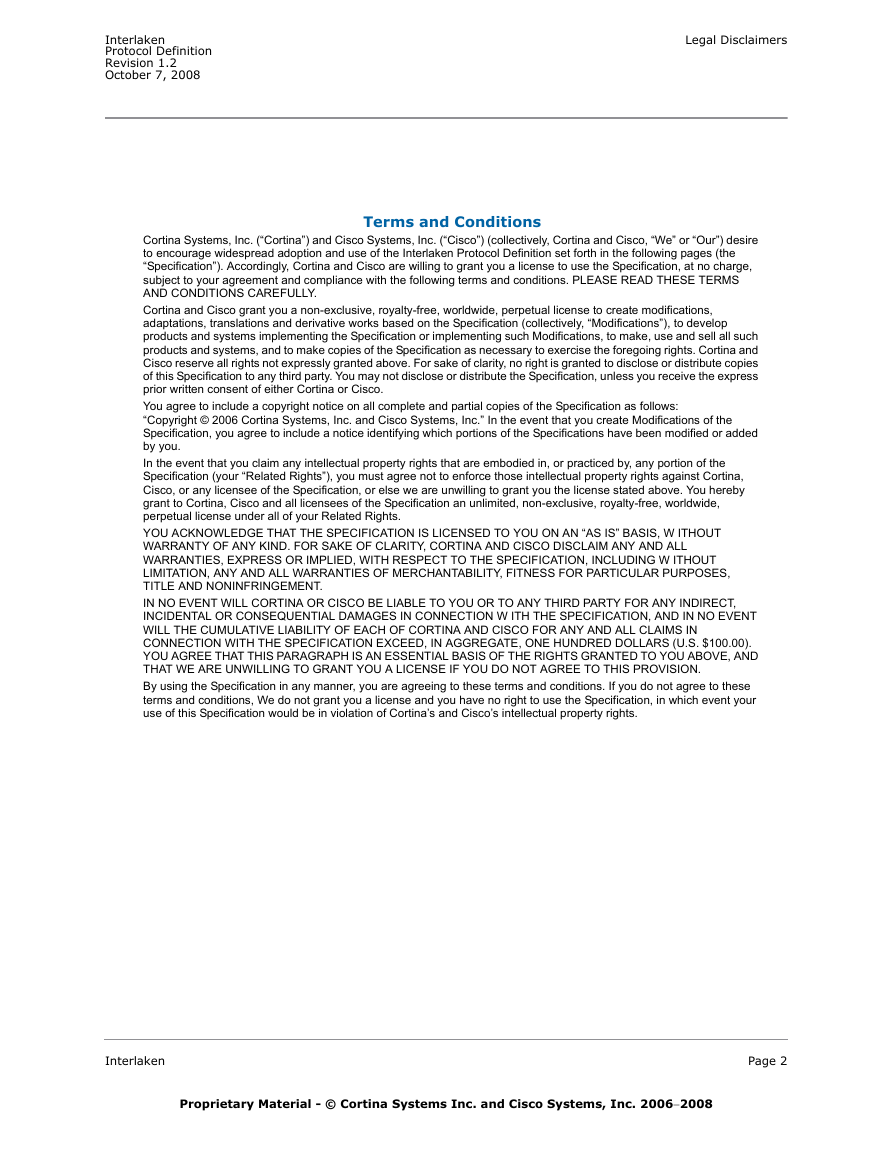
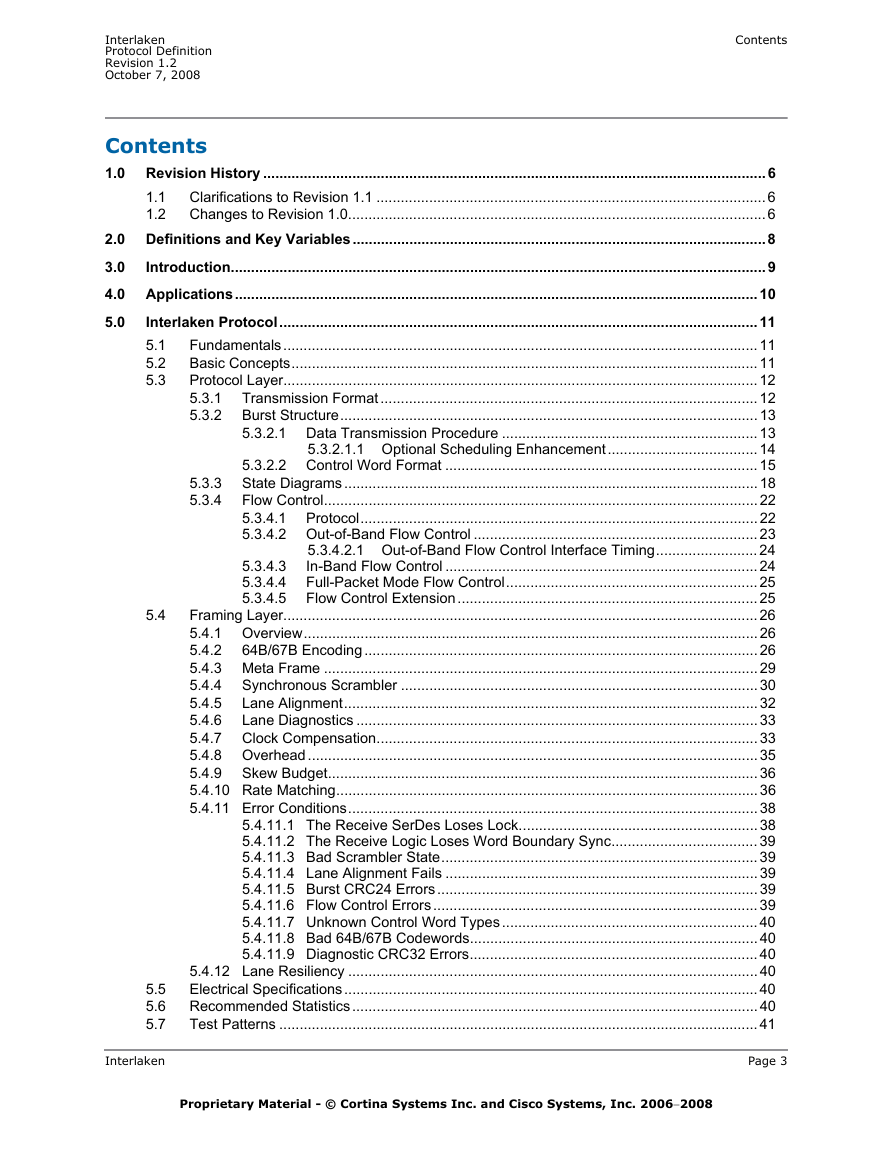
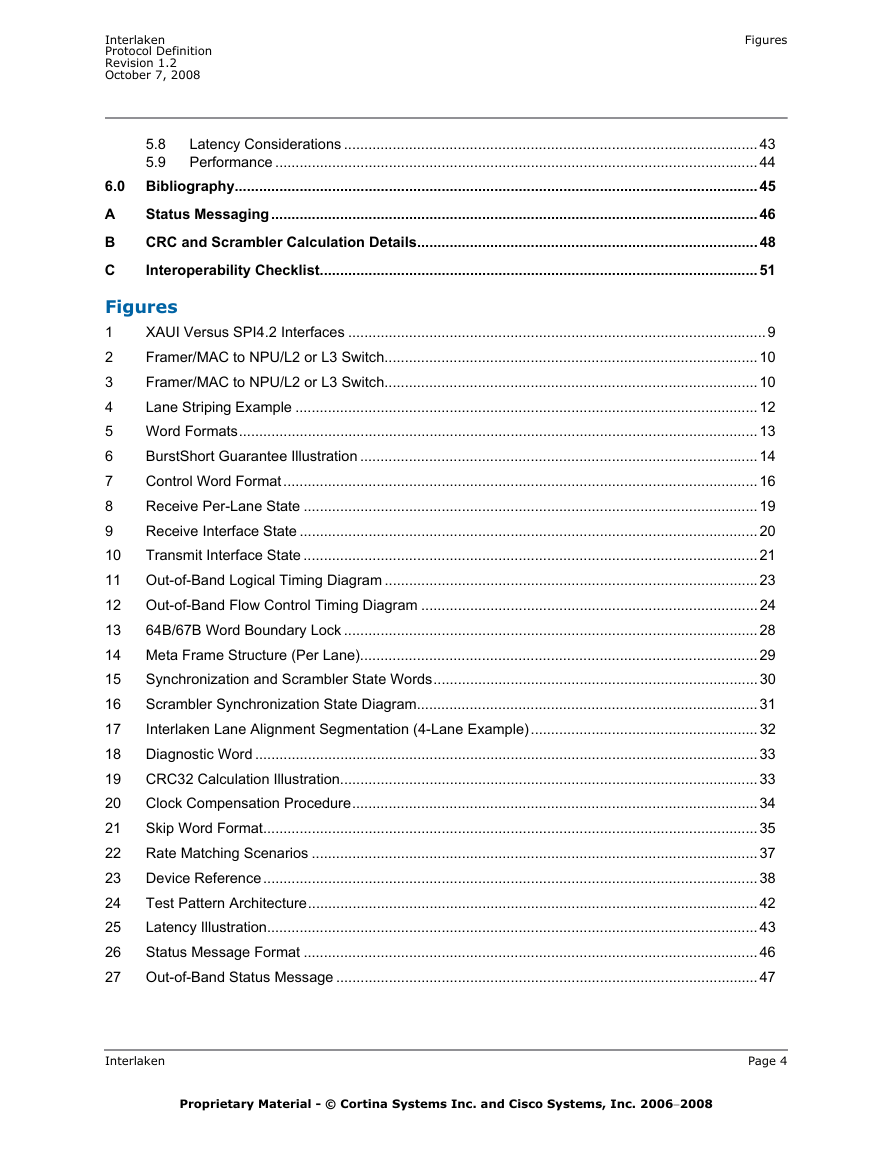

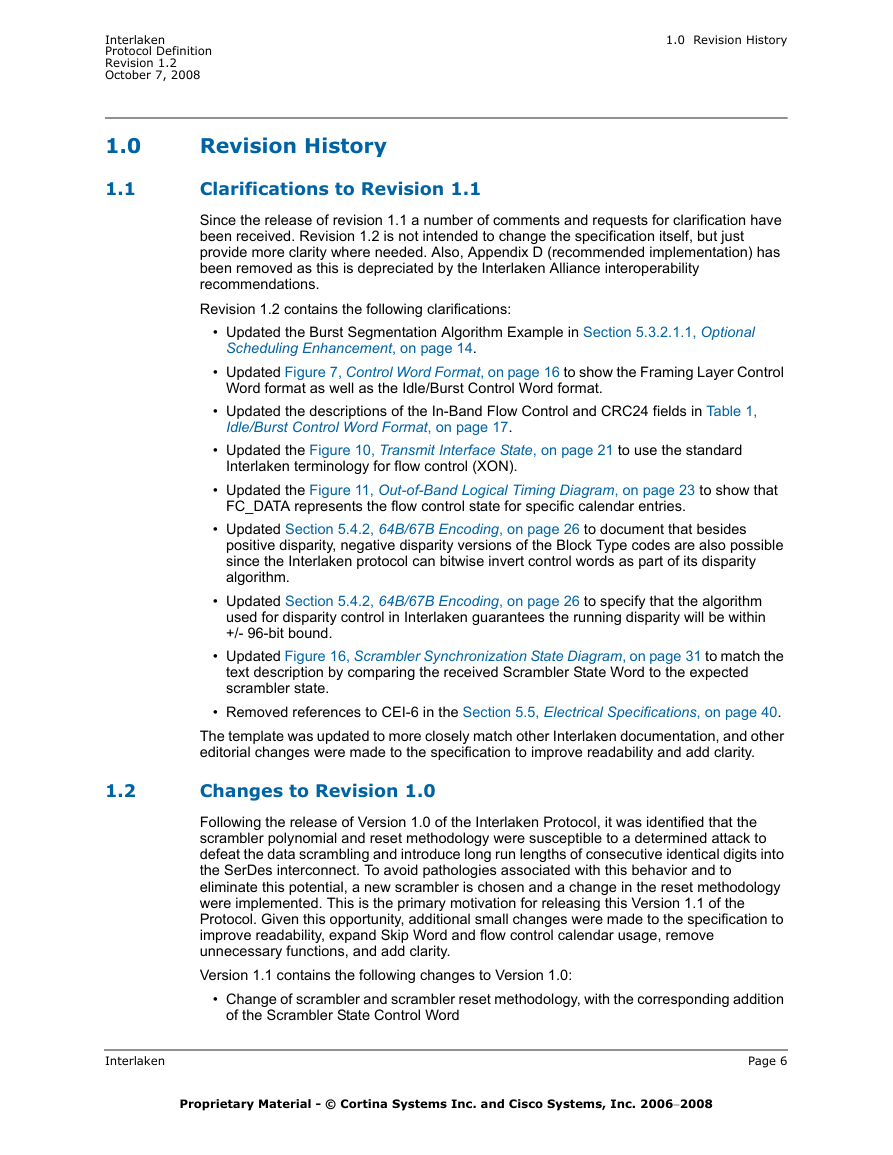
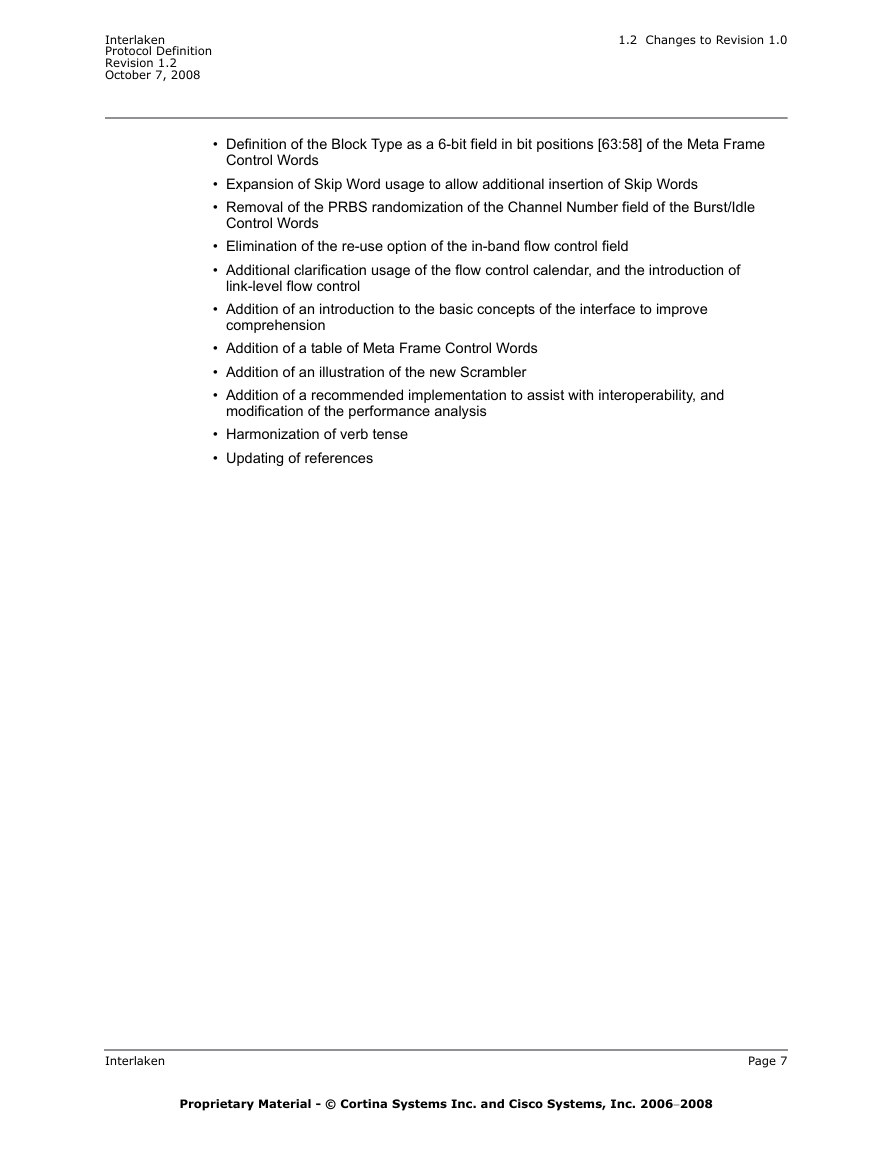
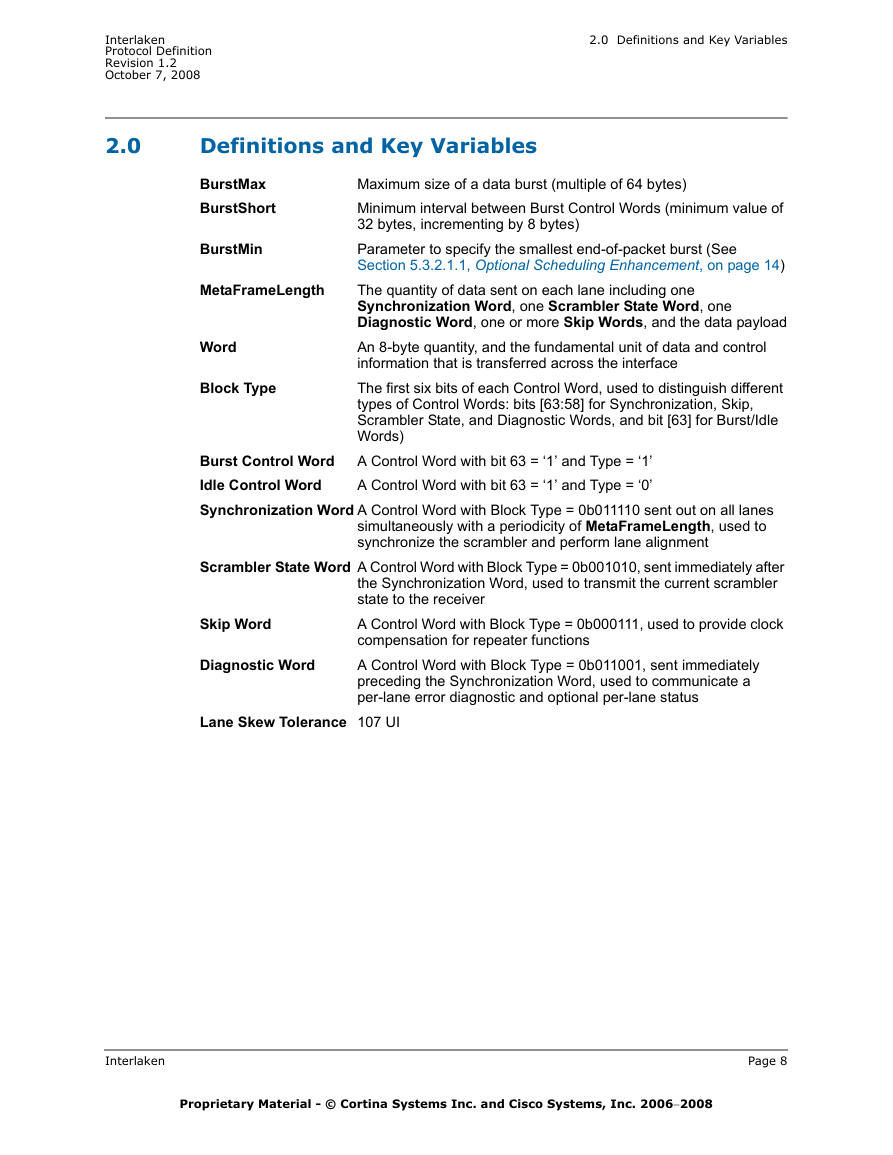








 2023年江西萍乡中考道德与法治真题及答案.doc
2023年江西萍乡中考道德与法治真题及答案.doc 2012年重庆南川中考生物真题及答案.doc
2012年重庆南川中考生物真题及答案.doc 2013年江西师范大学地理学综合及文艺理论基础考研真题.doc
2013年江西师范大学地理学综合及文艺理论基础考研真题.doc 2020年四川甘孜小升初语文真题及答案I卷.doc
2020年四川甘孜小升初语文真题及答案I卷.doc 2020年注册岩土工程师专业基础考试真题及答案.doc
2020年注册岩土工程师专业基础考试真题及答案.doc 2023-2024学年福建省厦门市九年级上学期数学月考试题及答案.doc
2023-2024学年福建省厦门市九年级上学期数学月考试题及答案.doc 2021-2022学年辽宁省沈阳市大东区九年级上学期语文期末试题及答案.doc
2021-2022学年辽宁省沈阳市大东区九年级上学期语文期末试题及答案.doc 2022-2023学年北京东城区初三第一学期物理期末试卷及答案.doc
2022-2023学年北京东城区初三第一学期物理期末试卷及答案.doc 2018上半年江西教师资格初中地理学科知识与教学能力真题及答案.doc
2018上半年江西教师资格初中地理学科知识与教学能力真题及答案.doc 2012年河北国家公务员申论考试真题及答案-省级.doc
2012年河北国家公务员申论考试真题及答案-省级.doc 2020-2021学年江苏省扬州市江都区邵樊片九年级上学期数学第一次质量检测试题及答案.doc
2020-2021学年江苏省扬州市江都区邵樊片九年级上学期数学第一次质量检测试题及答案.doc 2022下半年黑龙江教师资格证中学综合素质真题及答案.doc
2022下半年黑龙江教师资格证中学综合素质真题及答案.doc